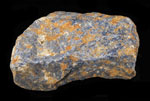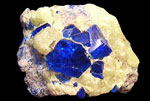Sodalite - Mineral and Healing Properties


Chemistry: Na4Al3(SiO4)3Cl, Sodium Aluminum Silicate Chloride.
Class: Silicates
Subclass: Tectosilicates
Group: Sodalite and feldspathoid groups.
Uses: mineral specimens and ornamental stone
CLICK HERE To Purchase Kidz Rocks Blue Sodalite Products.
-
 Sodalite
Sodalite -
 Crystal in Matrix
Crystal in Matrix
Sodalite is a scarce mineral that can be rock forming. Sodalite is named in reference to its sodium content. It is used for carvings and some jewelry pieces. Its light to dark pure blue color is well known in the semi-precious stone trade. Sodalite is a member of the feldspathoid group of minerals. Minerals whose chemistries are close to that of the alkali feldspars but are poor in silica (SiO2) content, are called feldspathoids. As a result or more correctly as a function of the fact, they are found in silica poor rocks containing other silica poor minerals and no quartz. If quartz were present when the melt was crystallizing, it would react with any feldspathoids and form a feldspar.
Localities that have feldspathoids are few but some produce large quantities of sodalite. Sodalite, when not blue, is hard to distinguish from other feldspathoids. It is the only feldspathoid that contains chlorine. Sodalite dissolved in a dilute solution of HNO3 gives a positive chlorine test obtained from some swimming pool test kits.

Origin Of The Name
The name Sodalite comes from the English words "sodium content". Sodalite was named in 1811 by Thomas Thomson for whom the mineral thomsonite was named. -- The following story is recorded: "A quantity of sodalite was sent to Denmark from Greenland during the Napoleonic Wars. It was captured by the British, however, and examined by a Glasgow chemist, Professor Thomas Thomson, who named it after its sodium content.

Interesting Facts
Some people seem to think sodalite, especially as used in jewelry, resembles lapis lazuli.
According to Wight (1993), hackmanite, a massive white variety of sodalite that turns pink on exposure to ultra viollet radiation, has also been used as a gemrock. This property, by the way, is called tenebrescence.
Sodalite has been known by many names. Alomite - trade name sometimes applied to sodalite from Bancroft, Ontario, Canada. Bluestone - name often applied in vernacular. Canadian bluestone - name sometimes given sodalite from the vicinity of Brancroft, Ontario, Canada. Canadian lapis - another name sometimes given Bancroft area sodalite. "Chameleon Sodalite"- name applied, usually in the vernacular, to a relatively recently discovered green variety of Sodalite found in Greenland. ?Princess Blue? - yet another name sometimes given Bancroft area sodalite.
Sodalite dissolves in dilute HNO3, and the resulting solution gives a positive chlorine test, even by using so-called swimming pool test kits. Some sodalite fluoresces yellow to orange in long-wave ultraviolet radiation.

Where Is It Found
Occurring typically in massive form, sodalite is found as vein fillings in plutonic igneous rocks such as nepheline syenites. It is associated with other minerals typical of undersaturated environments, namely leucite, cancrinite and natrolite. Other associated minerals include nepheline, titanian andradite, aegirine, microcline, sanidine, albite, calcite, fluorite, ankerite and baryte.
Significant deposits of fine material are restricted to but a few locales: Bancroft, Ontario, and Mont-Saint-Hilaire, Quebec, in Canada; and Litchfield, Maine, and Magnet Cove, Arkansas, in the USA. The Ice River complex, near Golden, British Columbia, contains sodalite. Smaller deposits are found in South America (Brazil and Bolivia), Portugal, Romania, Burma and Russia. Hackmanite is found principally in Mont-Saint-Hilare and Greenland.
Euhedral, transparent crystals are found in northern Namibia and in the lavas of Vesuvius, Italy.

What Do We Do With It
Sodalite is used almost exclusively as a decorative stone and in mineral collections. Cabochons for many different pieces of jewelry, beads (round, faceted and irregular - tumbled), wands, spheres and carvings.
Apparently Princess Mary liked the stone so much that 130 tons of it were quarried and sent to London to decorate Marlborough House.

Metaphysical Uses
Sodalite is a stone of logic, rationality, and efficiency. It is helpful for work in groups and stimulates thought. Sodalite is a stone that is good for healing breaches in communication. It is a stone of truth, and brings this to all communications. It is called a Poet's Stone. It can help end arguments or other disagreements.
It is particularly useful for honesty of emotions and love. It increases intelligence, knowledge and learning, and can unite the logical with the spiritual. Physically it is said in folklore and crystal healing to be beneficial for the glands, diabetes, digestive system, lymphatic cancer, relieving insomnia, and decreasing calcium deficiency. It is also used in crystal healing for quicker relief of head colds. Sodalite is associated with the throat and brow chakras.

Physical Characteristics
Color: Blue, white, gray, or even green.
Luster: Vitreous or greasy
Transparency: : Crystals are transparent to translucent, massive specimens are opaque.
Crystal System: Isometric; bar 4 3/m
Crystal Habits: Dodecahedral crystals have been found, usually massive as a rock forming mineral.
Cleavage: Poor, in six directions, but rarely seen.
Fracture: Uneven
Hardness: 5.5 - 6.0
Specific Gravity: 2.1 - 2.3
Streak: White
Associated Minerals: calcite, nepheline, cancrinite and other feldspathoids.
Other Characteristics: It is the only feldspathoid to give a positive chlorine test when dissolved in a HNO2 dilute solution.
Best Field Indicators: Color if blue, lack of pyrite association (as in lazurite), hardness and associations.

Educational Videos




